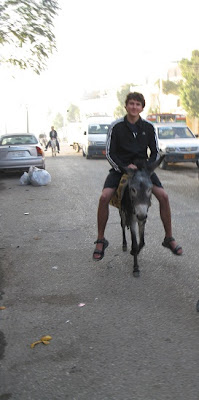 |
| Temple of Luxor |
By the time Luxor came on our agenda we’d been touring
 |
| Temple of Luxor from Across the Nile |
 |
| Temple of Karnak |
 |
| Columns at Karnak |
 |
| Granite Obelisk at Karnak |
 |
| Select your Ride this one has only been driven by an old lady on Sundays ... |
 |
| Is that a dog or a donkey? |
 On our third morning in Luxor we caught a ferry to the other side of the river and hopped on the back of some donkeys and rode to the Valley of the Kings. Ross ended up with a pint-sized donkey that was barely tall enough to keep his feet off the ground. Jessie loved her donkey – what a surprise, Marina’s was a bit pokey, and mine was the herd’s ‘bad boy’. We had to separate my donkey from Jessie’s because he kept biting her ass’ ass (couldn’t resist) –
On our third morning in Luxor we caught a ferry to the other side of the river and hopped on the back of some donkeys and rode to the Valley of the Kings. Ross ended up with a pint-sized donkey that was barely tall enough to keep his feet off the ground. Jessie loved her donkey – what a surprise, Marina’s was a bit pokey, and mine was the herd’s ‘bad boy’. We had to separate my donkey from Jessie’s because he kept biting her ass’ ass (couldn’t resist) –  |
| Keep those feet up Ross! |
We dismounted, thankfully as my hips were on fire, and mounted up into the back of a Landcruiser for a couple minutes ride to the entrance of the Valley of the Kings. Once inside we had tickets to visit three tombs out of the 15 or so that are open there. We chose not to enter Ramses II’s tomb (the nicest of all) and Tutankhamen’s – the most basic as he was an unimportant king that died at age 18 and was buried in an inconspicuous place – hence why they found his tomb intact with 1.6 tonnes of Gold .. plus all the other pieces. It’s hard to imagine the amount of treasure a truly wealthy long-serving king like Ramses II (67 years) would have had in his tomb. [No Photos Here ... they collected the cameras]
 |
| OMG Another Freaking Temple |
 |
| Valley of the Queens Entrance |
 |
| Pigeon Hole Tombs in the Valley of the Queens |
 |
| The view inside the Columns |
 |
| Sunset from the Hotel Rooftop |

Hi Matt,
ReplyDeleteOnly just started following as Craig Archer told me this site was up. Your last post shows you in Egypt. Hoping you have made it out OK!
Danny Aldham